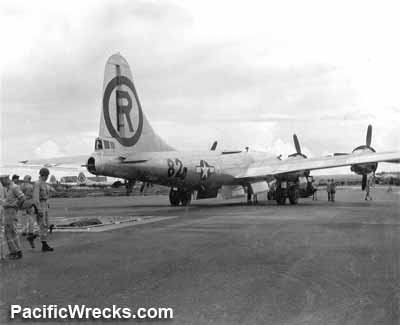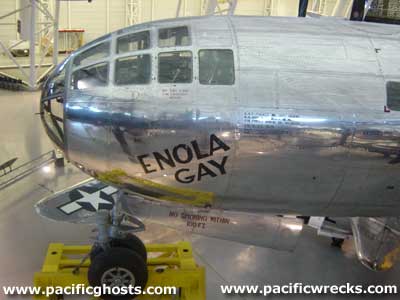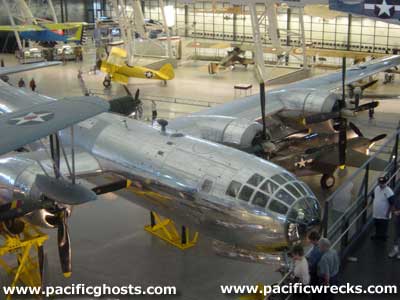|
|
|
|
| Missing In Action (MIA) | Prisoners Of War (POW) | Unexploded Ordnance (UXO) |
| Chronology | Locations | Aircraft | Ships | Submit Info | How You Can Help | Donate |
|
| USAAF 20th AF 509th CG 393rd BS   USAAF August 1945   Justin Taylan 2004 |
Aircraft History Built by Maritn-Omaha as a B-29-45-MO Superfortress at the Glenn L. Maritn Aircraft Plant in Bellevue, Nebraska. On May 9, 1945 while on the production line, one of fifteen bombers selected by Colonel Paul W. Tibbets, Jr., Commanding Officer (C. O.) for "Silverplate" the code name for the U.S. Army Air Force (USAAF) portion of the Manhattan Project to drop atomic bombs on the home islands of Japan. On May 18, 1945 delivered to the U.S. Army Air Force (USAAF) as B-29-45-MO Superfortress serial number 44-86292. Assigned to crew B-9 under the command of Captain Robert A. Lewis. On June 14, 1945 flown to Wendover Army Air Field, Utah. Wartime History Assigned to the 20th Air Force (20th AF), 509th Composite Group (509th CG), 393rd Bombardment Squadron (393rd BS) whose mission was to drop the first atomic bombs used in combat against Japan. On June 27, 1945 took off from Wendover Army Air Field on a ferry flight to Guam for additional bomb bay modification. On July 6, 1945 flown to North Field on Tinian. Assigned victor number 12. to Captain Robert A. Lewis During the remainder of July 1945, this B-29 made eight training missions plus two combat mission dropping "pumpkin bombs" (non-nuclear replica of the "Fat Man" bomb) on Kobe and Nagoya. On July 31, 1945 flew a training mission for the atomic bombing mission. On August 1, 1945 assigned victor number 82 painted in black on the nose and tail markings of circle R of the 6th Bombardment Group (6th BG) as a security measure to give the appearance of a conventional bomber. On August 5, 1945 Colonel Paul W. Tibbets, Jr. assumed command and that same day nicknamed this bomber "Enola Gay" after his mother Enola Gay Tibbets. The nickname was painted in black block letters on the left side of the nose by Allan L. Karl. Hiroshima Mission On August 6, 1945 loaded from Atomic Bomb Pit No. 1 with the atomic bomb nicknamed "Little Boy". For the mission, this B-29 was flown by aircraft commander Major Charles W. Sweeney with crew C-15 (normally assigned to B-29 "The Great Artiste" 44-27353). Pilot Colonel Paul W. Tibbets, Jr. Co-Pilot Captain Robert A. Lewis Bombardier Major Thomas Feebee Navigator Captain Theodore "Dutch" Van Kirk Weaponeer Captain William S. "Deak" Parsons, USN Radar Countermeasures 1st Lt. Jacob Beser Asst Weaponeer 2nd Lt. Morris R. Jeppson Tail Gunner SSgt George Robert "Bob" Caron (Flatbush, NY) Engineer SSgt Wyatt E. Duzenbury Radar Sgt Joe S. Stiborik Asst Engineer Sgt Robert H. Shumard VHF Radio Pfc Richard H. Nelson At 2:45am took off from North Field on Tinian piloted by Colonel Paul W. Tibbets, Jr. on a flight with the first leg passing over Iwo Jima then northwest bound for the primary target Hiroshima with alternate targets of Kokura and Nagasaki. At 8:15am from an altitude of 31,600' over Hiroshima released the atomic bomb and fifty seconds later it detonated. Afterwards, returned to North Field Airfield on Tinian landing at 2:58pm. Nagasaki Mission On August 9, 1945 took off piloted by Captain George W. Marquardt and crew B-10 (normally assigned to B-29 "Up An' Atom" 44-27304) on a weather reconnaissance mission over Kokura and reported clear skies as the target for the second atomic bomb. When B-29 "Bockscar" 44-27297 reached Kokura it was obscured by smoke from the conventional bombing of Yawata and after three unsuccessful bombing runs diverted to the secondary target of Nagasaki. Pilot Captain George W. Marquardt Co-Pilot 2nd Lt. James M. Anderson Navigator 2nd Lt. Russell Gackenbach Bombardier Captain James W. Strudwick Radar Countermeasures 1st Lt. Jacob Beser Engineer TSgt James R. Corliss Radio Sgt Warren L. Coble Radar Sergeant Joseph M. DiJulio Asst Engineer Sgt Anthony D. Capua Jr. Tail Gunner Sgt Melvin H. Bierman On November 6, 1945 flown back to the United States by Captain Robert A. Lewis. Postwar This B-29 operated from Roswell Army Air Field in New Mexico. In 1946, during "Operation Crossroads" flown from the United States to Kwajalein but was not used to drop any of the atomic bombs that were tested. Afterwards, transferred to the Smithsonian Institution, and spent many years parked outdoors at U.S. air bases. In 1961, transported to the National Air & Space Museum (NASM) Paul Garber Facility. Between 1984–1995 the wings, engine and cockpit were restored for a special exhibit. Between 1995–2003 the rest of the restoration was completed. On April 10, 2003 the fuselage and wings were assembled into a complete aircraft. Restoration By 1995, the wings, engine and cockpit were placed on display at the NASM Paul Garber Facility. During March 2003 to June 2003, the restored pieces were shipped to the new National Air & Space Museum (NASM) Udvar-Hazy Center. Display During 1995, on the 50th anniversary of 1945, the wings, engine and cockpit were displayed at the National Air & Space Museum as part of the exhibit "The Crossroads: The End of World War II, the Atomic Bomb and the Cold War". This was the first time "Enola Gay" had ever been displayed in public and the accompanying exhibit was deemed controversial because some felt it focused too much on the Japanese side of the bombing . As a result of the controversy, National Air and Space Museum director Maritn O. Harwit resigned. In protest to the exhibit and the display of "Enola Gay", a protester threw red paint on the carpet to represent blood. On July 2, 1995, three people were arrested for throwing ash and human blood on the fuselage. On May 18, 1998 the exhibition closed due to public opinion and protest. Afterwards, the pieces displayed were returned to the NASM Paul Garber Facility to complete the restoration of the entire bomber. On April 10, 2003 the fuselage and wings were assembled at National Air & Space Museum (NASM) Udvar-Hazy Center. On December 15, 2003 the fully restored B-29 was unveiled during the opening of the National Air & Space Museum (NASM) Udvar-Hazy Center. For the permanent display, the bomber is lifted off the ground with jacks with catwalks allowing visitors to see the nose view and look down from above. A clear protective shield blocks the nose from vandalism by protesters. Memorials Caron passed away June 3, 1995 at age 75. He is buried at Fort Logan National Cemetery at section 8, site 1106. Tibbets passed away November 1, 2007 at age 92. He was cremated with his ashes scattered across the English Channel. References USAF Serial Number Search Results - B-29-45-MO Superfortress 44-86292 "86292 To the Martin Modification Center, Omaha, NB, for Code Silverplate conversion for the carriage of atomic weapons. Converted to Silverplate Victor number 82, was *Enola Gay*, which dropped atomic bomb on Hiroshima Aug 6, 1945. For many years was in storage at Paul Garber facility at NASM, Washington DC. Fuselage put on display at NASM for 50th anniversary of Hiroshima bombing. Has now been moved to and is fully assembled at the Smithsonian's Steven F. Udvar-Hazy Center at Washington-Dulles IAP." The Silverplate Bombers: A History and Registry of the Enola Gay and Other B-29s Configured to Carry Atomic Bombs (2012) by Richard H. Campbell FindAGrave - Virtual Cemetery Enola Gay Crew FindAGrave - BG Paul Warfield Tibbets, Jr (photos, biography) FindAGrave - George Robert “Bob” Caron (photos, grave photo) Contribute
Information Last Updated
|
B-29 Photo Archive |
| Discussion Forum | Daily Updates | Reviews | Museums | Interviews & Oral Histories |
|